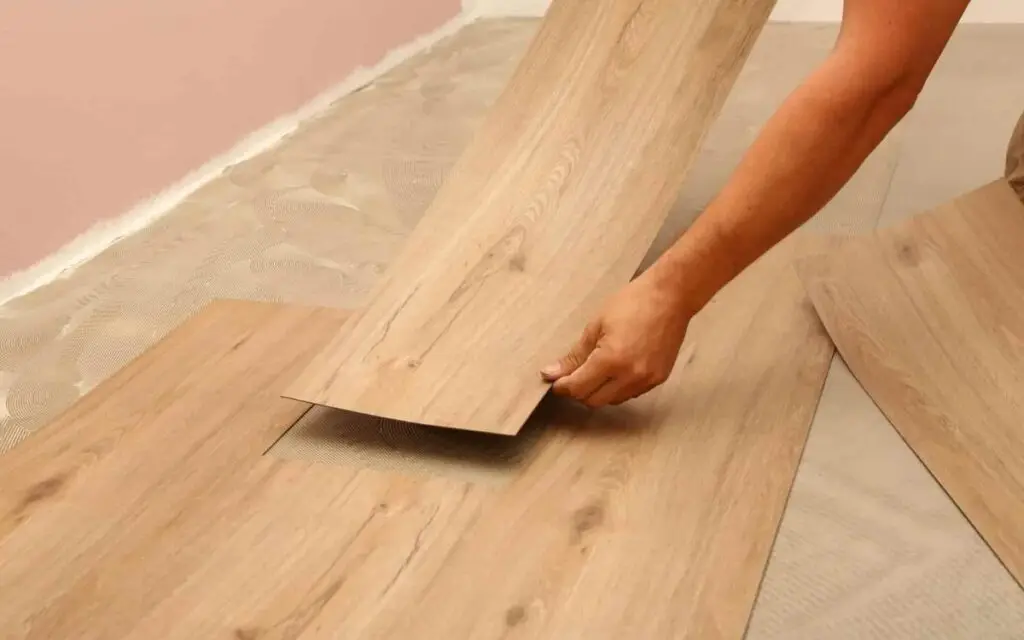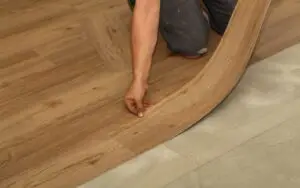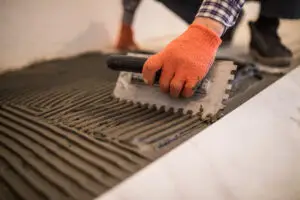Understanding Glue-Down and Floating Vinyl Plank Installation
Glue-Down Vinyl Plank Installation
How It Works
Glue-down vinyl plank installation involves applying a specialized adhesive to the subfloor and then carefully adhering each vinyl plank directly to the adhesive. This method creates a strong and permanent bond between the planks and the subfloor. Because of the nature of this method, it is absolutely essential that the subfloor is perfectly prepared and that the planks are installed precisely, and with expert techniques.
Key Benefits
The primary benefit of glue-down installation is its exceptional stability and durability. Because the planks are directly bonded to the subfloor, they are less likely to shift or move under heavy traffic or furniture. This method also minimizes the feeling of hollowness underfoot, providing a solid and comfortable surface. When a glue down install is done correctly, the results are excellent and are long lasting, which is why this method is preferred by some professionals.
Floating Vinyl Plank Installation
How It Works
Floating vinyl plank installation involves interlocking the planks together using a click-lock or tongue-and-groove system. This creates a “floating” floor that is not directly attached to the subfloor. An underlayment is usually placed between the subfloor and the planks to provide cushioning and reduce noise. Because of the ease of this type of install, it is often preferred by many DIYers.
Key Benefits
The main benefits of floating vinyl plank installation include its ease and speed of installation, making it a popular choice for DIYers. This method also allows for easier removal or replacement of planks if necessary and is slightly more forgiving with minor subfloor imperfections. However, floating vinyl plank flooring may not be as stable as glue-down in some cases. Professionals can help choose the best option for your specific application.
Comparing Glue-Down vs. Floating Installation
Durability and Stability
How Each Method Performs
Glue-down installation provides superior stability and durability, making it ideal for high-traffic areas and commercial settings. Because of the tight bond between the planks and the subfloor, there is less movement and shifting, leading to a more long-lasting flooring solution. Floating vinyl plank, while durable, may not be as stable under heavy use. When making the choice, it is important to consider your specific needs and the needs of your space.
When Glue-Down is Preferred
Glue-down installation is generally preferred in commercial settings, areas with heavy foot traffic, or areas with direct sunlight or high temperatures, where stability is critical. It is also recommended for uneven subfloors that require leveling compounds, or when an extremely long lasting flooring solution is needed. These reasons make glue down the preferred method by many professionals.
Installation Process and Time
Ease of Installation
Floating vinyl plank installation is typically easier and quicker, and is very popular with DIYers. The click-lock or tongue-and-groove system makes it easier for planks to connect and be laid on the floor, and does not require any adhesives or special tools. Glue down installs, however, require adhesives, more time, and more knowledge, making them a better fit for professionals who are very familiar with this type of installation.
Time Considerations
Glue-down installations can be more time-consuming due to the need for subfloor preparation, precise adhesive application, and proper drying time. While floating installs are faster, a professional installer will always get the job done faster, and more correctly, than most DIYers. When time is an issue, it is always best to hire a professional.
Subfloor Requirements
Preparing for Glue-Down
Glue-down installation requires a perfectly flat, smooth, and level subfloor. Any imperfections in the subfloor will affect the bond and performance of the flooring. The subfloor must also be completely dry before beginning the process. These requirements make glue-down installation much more difficult for DIYers, and much more in the wheelhouse of a professional installer.
Preparing for Floating
Floating vinyl plank installation is more forgiving with minor subfloor imperfections. However, it’s still essential to ensure the subfloor is clean, dry, and relatively level. An underlayment is usually placed on top of the subfloor to provide a smooth base. Even with the ease of the floating system, it is still best to have a professional prepare the subfloor to ensure the highest quality results.
Advantages and Disadvantages of Each Method
Pros and Cons of Glue-Down
When To Use Glue Down
Glue-down installation is ideal for areas requiring maximum stability, such as commercial spaces, high-traffic areas, and rooms exposed to extreme temperatures. It is also best used for areas where the flooring is expected to last for many years, and does not need to be moved or changed in the near future. Professional installers can assess your specific needs to determine if glue down is the correct method for your space.
Challenges With Glue Down
The challenges of glue down include a more time-consuming and difficult installation, a required perfectly flat and smooth subfloor, and more difficult removal or replacement of planks. These challenges often lead DIYers to choose floating floors, while professional installers are very adept at overcoming all of these issues.
Pros and Cons of Floating
When To Use Floating
Floating vinyl plank is a great choice for residential spaces with light to moderate traffic, or areas where easy removal is a priority. It is also useful in rooms where minor imperfections are present in the subfloor. Professional installers know all of the best practices, and can also give you a very high-quality installation, even when using a floating floor.
Challenges With Floating
The challenges with floating vinyl plank include less stability than glue down, and a more hollow sound when walking. While underlayment can help these issues, they will always be present to some extent when compared to a glue down floor. When stability is the main concern, glue down is always the best option, and is often recommended by professionals.
DIY vs. Professional Vinyl Plank Installation
DIY Installation Challenges
Potential for Errors
DIY vinyl plank installations, regardless of the method, are prone to several common errors. These include improper subfloor preparation, misaligned planks, and incorrect adhesive use. These mistakes can often lead to an uneven floor, premature wear, and the need for extensive rework. Professional installers are well-trained to avoid all of these issues.
Tool Requirements
Both methods of installation require specific tools, such as a tapping block, pull bar, spacers, a utility knife, and a measuring tape. In addition to these basic tools, glue down installs require trowels, and other specialized tools. The tool requirements of both methods can be costly, especially when you consider that all professionals will already have all of these tools.
Benefits of Professional Installation
Expertise and Efficiency
Professional installers have extensive experience with both glue down and floating installs, and have the expertise and skills to properly prepare the subfloor, select the best method, and install the flooring correctly and efficiently. They can also handle all the complexities of any type of job, and can provide high-quality results that are both beautiful and long-lasting.
Long-Term Value
While professional installation might have a higher upfront cost, it offers long-term value by preventing costly mistakes and ensuring a durable, long-lasting installation. Professionals also offer warranties on their work, which provides an extra level of protection that DIY projects cannot. Because of all of the long term benefits, it is always recommended to hire a professional.
Case Studies: Glue vs. Float Installations
Example of a Successful Glue-Down Install
A homeowner with a high-traffic living room decided to install glue-down vinyl plank flooring, and hired a professional installer to do the job. The installer properly prepared the subfloor, and used precise techniques to install the vinyl planks with a specialized adhesive. The result was a stable, durable, and beautiful floor that was perfect for the busy family.
Example of a Successful Floating Install
Another homeowner wanted to install new flooring in their master bedroom and chose floating vinyl plank for its ease of installation, and for the added comfort of a softer underlayment. They hired a professional installer who completed the job quickly and efficiently, and with beautiful results.
FAQs & Answers
Glue-down vinyl plank installation involves adhering each plank directly to the subfloor using a specialized adhesive, creating a very secure and stable surface. Floating vinyl plank, on the other hand, involves interlocking the planks together and laying them over an underlayment, without adhering them to the subfloor. Professionals can help you determine the best method for your space.
Glue-down installation is typically preferred for areas with high traffic, commercial settings, or uneven subfloors, where maximum stability and durability are needed. It's also often recommended for rooms that will be exposed to high temperatures or direct sunlight. Professional installers will always consider these factors and advise you on the best option for your specific needs.
Floating vinyl plank is generally easier and quicker to install, making it a popular choice for DIYers. It also allows for easier removal or replacement of planks if necessary, and can work with slightly uneven floors and provide some level of comfort. However, floating vinyl plank may not be as stable as glue-down in high-traffic areas. Professional installers have the skills and tools to maximize the benefits of floating vinyl plank, while minimizing the potential for issues.
While glue-down installation provides excellent stability, it can be more challenging and time-consuming to install than floating. It also requires a very flat and smooth subfloor and makes the planks more difficult to remove or replace. Because of all of these specific considerations, it is very important to ensure that any glue down install is done correctly from the start. Professional installers ensure that the glue-down installation is done perfectly, using proper techniques, and high-quality adhesives.
Professional installers have the knowledge, experience, and tools necessary to ensure a successful vinyl plank flooring installation, regardless of whether it’s glue-down or floating. They begin by assessing the subfloor, and selecting the appropriate materials for the job. They then use precise techniques to ensure the planks are installed perfectly, minimizing any potential problems, and guaranteeing a high-quality result.





